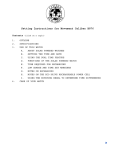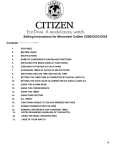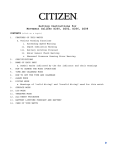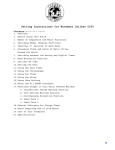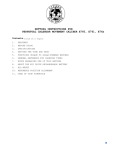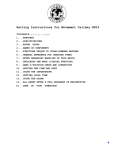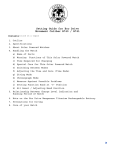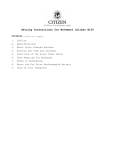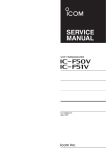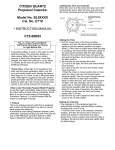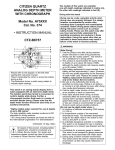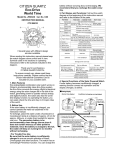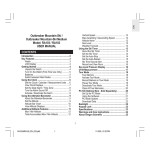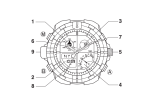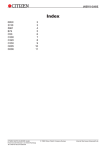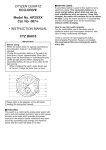Download Citizen C320 Instruction manual
Transcript
CITIZEN QUARTZ PROMASTER NAVISURF Model No.JN2XXX Caliber No.C320 • Instruction Manual CTZ-B6804 Thank you for purchasing a CITIZEN QUARTZ Watch. To ensure correct use, please read these instructions carefully. Please confirm that the CITIZEN International Guarantee Card is included for your possible claim. 3. SWITCHING FUNCTIONS (MODES) The mode changes each time button M button is pressed. The mode hand indicates the current mode. 4. GREENWICH MEAN TIME (UTC) AND TIME DIFFERENCE When reading this instruction manual please keep the watch diagram at left folded out and in view. Symbols ( 嘷 A, 嘷 B , etc.) used in the sections on operating instructions refer to the symbols indicated in this diagram. 1. PRODUCT FEATURES This watch can easily retrieve Greenwich Mean Time (UTC) and the time and calendar for 23 cities around the world by simple button operation. In addition, this combination watch also features a racing timer useful in yacht racing and other competitions, an alarm function and chronograph. 2. NAMES OF COMPONENTS Verify the locations of components by comparing with the illustration inside the front cover of this manual. • Those cities (regions) that use Daylight Savings Time are indicated with a circle, while those (regions) that do not are indicated with an X. • The time differences and use of Daylight Savings Time in each country are subject to change in accordance with the regulations in that country. 5. SETTING THE TIME <Digital Time Setting (TME)> ■ When the time is set for any city, the times in other cities are set automatically. [Normal Time Display] * 4. 5. 6. 1. Press button 嘷 M and set the watch to TME mode. 2. Press button 嘷 A or 嘷 C, and display the name of the city for which the time is to be set. 3. Pull out button 嘷 M . The hours, minutes and seconds of the digital display will start to flash. The time can be switched to Daylight Saving Time as this time. Press button 嘷 C to switch to Daylight Saving Time for that city. When the Daylight Saving Time is displayed the word “SUMMER” will be displayed. Each time button 嘷 A is pressed, the display will change in the order of SUMMER, seconds, minutes, hours and 12H/24H (12 hour or 24 hour) display. Since the flashing digit of the display changes each time button 嘷 A is pressed, press button 嘷 A until the digit of the display you want to correct flashes Press button 嘷 C to set the flashing digit of the display (continuously pressing button 嘷 C will cause the number displayed to advance rapidly). • When setting to a 12 hour display, make sure the display for AM/PM is correct. Push button 嘷 A back into the normal position, completing the digital time setting. • Daylight Savings Time can be set independently for each city. <Analog Time Setting> Analog cannot be set alone. However, analog time can be set by switching the digital and analog display. Refer to section 7 entitled, “Switching Between Analog Time and Digital Time”. (Page 14) 6. SETTING THE CALENDAR ■ When the calendar is set for any city, the calendar for the other cities are set automatically. [Normal Calendar Display] 1. Press button 嘷 M and set the watch to the CAL mode. 2. Press button 嘷 A or button 嘷 C to display the city for which you want to set the calendar. 3. Pull out the 嘷 M button. The “month” of the digital display will start to flash. 4. Since the flashing digit of the display will change each time button 嘷 A is pressed in the order of month, date, day and year, press button 嘷 A until the digit of the display you want to correct flashes. 5. Press button 嘷 C to correct the flashing digit of the C will display (continuously pressing button 嘷 cause the number displayed to advance rapidly). 6. Push button 嘷 M back into the normal position, completing the calendar setting. • The year can be set from the years 1995 to 2099. • Since this watch is equipped with an autocalendar function, there is no need to correct the date at the end of the month. • When the date has been set to a date that does not exist (such as February 30), the watch will automatically correct the date to the 1st of the following month when return to the normal display. 7. SWITCHING BETWEEN ANALOG TIME AND DIGITAL TIME This watch is designed for simple switching between digital and analog displays for cities and calendars. 1. Press button 嘷 M and set the watch to the TME or CAL mode. 2. Press button 嘷 A (to advance the name of the cities forward) or button 嘷 C (to advance the name of the cities backward) to display the desired city. 3. Simultaneously press buttons 嘷 A and 嘷 C. A confirming beep will be produced indicating that the times (calendar) of the cities designated for digital have been interchanged. 8. DISPLAYING TIME AND CALENDAR OF MAJOR CITIES OF THE WORLD 1. Press button 嘷 M and set the watch to the TME or CAL mode. 2. Press button 嘷 A (to advance the name of the cities forward) or button 嘷 C (to advance the name of the cities backward) to display the desired city. 9. USE OF ZONE SETTING (SET) ■ In the zone setting function, only the cities selected “SET” can be retrieved and displayed in each mode easily. [Zone Setting Mode] <Zone Setting> 1. Press button 嘷 M and set the watch to the SET mode. 2. Press button 嘷 A or button 嘷 C to display the city that you want to set. 3. Pull out button 嘷 M . The name of the city and the word “SET” of the digital 3. display will begin to flash. At this time, select “SET” or “OFF” for display of the city by pressing button 嘷 B. A or • When setting other cities, first press button 嘷 嘷 C to display the city desired to be corrected, and then set for each city using button 嘷 B. 4. After completing settings for each city, push button 嘷 M to the normal position to complete the setting procedure. 10. USE OF RACING TIMER (R-1/R-2) ■ This watch has the following two kinds of race timer, which are convenient for yacht races, etc. 1. Race Timer 1 (R-1) : It has no auto-repeat function which repeats timing from the set time to time up three times automatically. This is convenient for repeating the starting practices, etc. ■ 2. Race Timer 2 (R-2) : It has an auto-chrono function which after time up, chronograph timing starts automatically, and you can measure the passed time since time up. <Setting Procedure> (Same for R-1 and R-2) • Race timer can be set from 60 minutes to 10 minutes in 5 minute intervals, and set to 6, 5, 3, 1 minute. 1. Press button 嘷 M and set the watch to either R-1 or R-2 mode. 2. Pull out button 嘷 M . The minutes digit of the digital 2. display will start to flash. At this time, press button 嘷 C until the time you want to set is flashing on the display (continuously pressing button 嘷 C will cause the number displayed to advance rapidly). 3. Push in button 嘷 M to the normal position to complete the setting procedure. • Both the digital display and analog display are shown during timer timing and auto-chronograph measurement. However, the maximum analog display during auto-chronograph measurement is 59 minutes and 59 seconds. The second hand and function hand will stop at the 00 minute 00 second position after that time. <Timer sound> When the timer has finished, a time up sound rings for about 5 seconds. Also an alarm sounds every minute between 10-1 minute and 50, 40, 30, 20, 10, 5, 4, 3, 2, 1 second to indicate the remaining time till time up. <Use of Racing Timer 1 (R-1)> • This race timer repeats the timer from set time to time up to three times automatically. Then returns to set time and stops. 1. When button 嘷 A is pressed, the timer will start to measure time from the set time. 2. The timer is stopped by pressing button 嘷 A during timing. • Press button 嘷 A again to restart timing. 3. When the timer is stopped, pressing button 嘷 C returns the timer to the set time. *1. Timer Fly Back (Restart) Function When button 嘷 C is pressed during timing, the timer will return to the set time and restart timing automatically. <Use of Racing Timer 2 (R-2)> This racing timer is equipped with an auto-chronograph function in which operation automatically switches to chronograph measurement simultaneous to time elapsing on the timer. The auto-chronograph function measures time for 24 hours and following completion of chronograph measurement, the timer returns to the set time and stops. 1. When button 嘷 A is pressed, the timer will start to measure time from the set time. 2. The timer timing or auto-chronograph measurement is stopped by pressing button 嘷 A. 3. When the timer or auto-chronograph is stopped, pressing button 嘷 C returns the timer to the set time. *1. Timer Fly Back (Restart) Function: When button 嘷 A is pressed during timing or time measurement with the auto-chronograph function, the timer will return to the set time and restart timing automatically. *2. Starting of Auto-Chronograph Measurement: Time measurement with the auto-chronograph will start automatically simultaneous to time elapsing on the timer. 11. USE OF CHRONOGRAPH (CHR) ■ This chronograph can measure and display time in 1/100 second units for a maximum of 23 hours 59 minutes 59 seconds. Following completion of measurement for 24 hours, it returns to the reset state and stops. In addition, it is also able to measure split time. [Chronograph Mode] <Accumulative Time Measurement> 1. The chronograph is started and stopped with button 嘷 A . (Measurement can be started and stopped repeatedly as often as desired by repeatedly pressing button 嘷 A during measurement.) 2. The chronograph can be reset by pressing button 嘷 A when it is stopped. <Split Time Measurement> 1. The chronograph is started and stopped with button 嘷 A. 2. When button 嘷 C is pressed during measurement, the split time will be displayed for 10 seconds. (The word “SPLIT” will flash during display of the split time.) Split time can be measured as many times as desired. 3. The chronograph can be reset by pressing button 嘷 C when it is stopped. * When button 嘷 C is pressed during display of the split time, the next split time will be displayed. 12. USE OF ALARMS 1 AND 2 (AL-1/AL-2) ■ The procedure for setting the alarm for alarm 1 and alarm 2 is exactly the same. Only the beeping tone is different. Once set (turned ON), the alarm will sound for 15 seconds at the same time every day. [Alarm ON Display] 3. 4. 5. 6. <Setting Procedure> 1. Press button 嘷 M and switch the watch to the “AL-1” or “AL-2” mode. 2. Press button 嘷 A or 嘷 C to display the name of the city for which you want to set the alarm. 3. Pull out button 嘷 M . The mark “ON” or ”OFF” will flash on the digital display. At this time, press button 嘷 C to select either ON or OFF. Press button 嘷 A until the digit of the display you want to set flashes. Press button 嘷 C to set to the correct setting (continuously pressing button 嘷 C will cause the display to advance rapidly). Push in button 嘷 M to the normal position. <Turning Off the Alarm> Pressing any of button 嘷 A,嘷 B or 嘷 C will turn off the alarm sound. • You can hear to the sound of the alarm at any time by pressing buttons 嘷 A and 嘷 C simultaneously when the watch is in the alarm mode (alarm sound monitor). • Since a 12 hour display will also be used for the alarm mode when the time mode is set to a 12 hour display, make sure that AM and PM are set correctly. 13. DISPLAY OF BUTTON FUNCTIONS This watch is provided with a digital display that indicates the function of each button. Refer to this display when desiring to know the function of a particular button. 14. CONVENIENT FUNCTIONS When display becomes illegible due to overlapping of digital display and analog hands: • This watch allows the hour and minute hands to be retracted when the display becomes difficult to see as a result of the hour and minute hands overlapping the digital display (hand retract function). ~Procedure~ 1. Press button 嘷 B for at least 2 seconds when “H.R.” is displayed on the digital display for the function of button 嘷 B . The hour and minute hands will begin to move toward the 12:00 position. 2. Once the hour and minute hands have been moved to a location that does not obstruct the view of the digital display, press button 嘷 B again and stop the movement of the hands. (If button 嘷 B is not pressed, the hands will continue to move until they reach the 12:00 position. ~Cancellation of Hand Retract Function~ • Press button 嘷 B one more time. ✰ The letters “H.R.” will flash during the time the hand retractor function is activated. ✰ H.R. is the abbreviation for “Hand Retract”. When the watch shows unusual display • When there appears to be a malfunction or abnormality in the display or operation of the watch (such as a portion of the display not being shown or the alarm continuing to sound), perform the full reset and hand zero positioning described below. ~All-Reset/Hand Zero Positioning Procedure~ • This procedure may be performed in any mode. 1. Press button 嘷 M to switch to the “CHR” mode. 2. Pull out button 嘷 M. 3. Simultaneously press buttons 嘷 A,嘷 B , and 嘷 C for at least 2 seconds. (The display will no longer be shown when these buttons are pressed.) 4. Release the buttons. (The entire digital display will flash.) 5. Push in button 嘷 M to the normal position. 6. Pull the 嘷 M button out again. At this time, digital display indicate “F_H”. 7. Each time button 嘷 B is pressed, the digital display will change in the order of “F_H”, “H.R.” and “SEC”. “F_H”: Allows zero positioning of function hand. “H.R.”: Allows zero positioning of hour, minute, and 24 hour hands. “SEC”: Allows zero positioning of second hand. 8. Press button 嘷 A or 嘷 C and set each of the hands to the 24 hour 00 minute 00 second position. Button 嘷 A : Setting by clockwise rotation of the hands. Button 嘷 C : Setting by counter-clockwise rotation of the hands. 9. Push in button 嘷 M to the normal position. Reset each mode to the proper time settings. ✰ The hands of the watch will not display time correctly unless the hands are properly aligned at the zero position. 15. USING THE BEZEL • This watch has a bezel function. • Some models are not equipped with this function. 1. Directional (rotating bezel type) 2. Yachting (rotating bezel type) 3. Conversion of km/naut/mile. 1. Directional rotating bezel (Northern hemisphere) The compass feature on this watch is based on the position of the sun. This compass should only be used as an approximate direction finder. Changes in latitude and the seasons may also cause directional misreadings. One of the features of this watch is a directional rotating bezel for use in the Northern Hemisphere. By aligning the hour hand with the position of the sun in the sky, the point halfway between this position and 12 o’clock will be South. Align the “S” mark on the rotating bezel with this halfway point to determine all other points of the compass. 2. Yacht race Many yacht races are set in triangulated course layouts such as the one described here where the winner is the boat that navigates the designated course around the marks in the fastest time. Direction: Navigational bearings are most often given in terms of degrees. North: 0° East: 90° South: 180° West: 270° Starboard: The right-hand side of a yacht when looking forward. Port: The left-hand side of a yacht when looking forward. Using the rotating bezel (1) 1. Before a race, determine the direction of the wind from the direction and position of the windward marker. Line up the number representing the wind direction (in degrees) in the bezel with the triangle (∆) mark at 12 o’clock (eg. northeasterly wind at 45°). 2. The course bearing from the windward mark to the wind mark (starboard reach) is read off the bezel, in degrees, at the green triangle (∆) on the bottom left side of the dial. 3. The course bearing from the wind mark to the leeward mark (port reach) is read off the bezel, in degrees, at the red triangle (∆) on the bottom right side of the dial. 4. When sailing from the windward mark to the leeward mark, the small white triangle at the bottom of the watch dial becomes the reference point for determining course bearings. Note that the above explanation is only valid for times when the ø angle is 45°. At 60°, use the values lying above the red and green triangle, and at 30° the values lying below the two triangles. Using the rotating bezel (2) Most present-day yachts are capable of sailing at 45° to the wind. To be in a position to be able to read the wind shift after the start of a race, make several runs before the race matching your course as close as possible to the red (or green) bars on the left (or right) upper portion of the watch face. Using the rotating bezel (3) By using the rotating bezel in the following way you can determine the angle between the start/finish and the direction from which the wind is blowing. The start/finish line is usually set at a right angle to the direction of the wing, but because the wind is always shifting direction, a true 90° angle is rarely encountered. In this case, line up the white triangle at the 12:00 position on the watch with the direction from which the wind is blowing. Sail from one end of the start/finish line to the other, using the white lines marked (at 3:00 or 9:00) on the watch to the white line, you are on a favourable heading to start the race when you cross the start/finish line. If the course steered falls to the minus (–) side of the white line on the watch, you know it is favourable to cross the start/finish on a heading from the opposite direction. * Use any one or a combination of the three methods described above to help you manoeuvre your boat into and maintain the position you feel is the most advantageous during a race. 3. Conversion of km/naut/mile • Calculation results should only be used as approximate indicators. • The calculator scale does not indicate decimal places. 1. Turn the rotating ring and see how many kilometres or knots one mile will correspond to. 2. Set the mile ▼ (or STAT ▼ = stature mile) to the 10 mark and look at the figure lying below the km ▼. This is equivalent in kilometres (= 1.6). 3. The figure located under the naut ▼ (or knot ▼ = nautical mile) is the equivalent in nauts (= 0.86). 4. Similarly, any desired distance can be converted to km/naut/mile. 16. PRECAUTIONS FOR LONG TERM USE 1. Water Resistance Check the chart to determine the water resistant properties of this watch. WATER RESIST may sometimes be the abbreviation of WATER RESISTANT. Do not operate any of the buttons when the watch is wet. 2. Avoid extreme temperatures Avoid leaving your watch in extremely warm or cold locations for long periods of time. 3. Avoid strong shocks 4. Avoid strong magnetic fields 5. Avoid chemicals and gases Avoid wearing the watch in the presence of strong chemicals or gases. If mercury or any chemical (such as gasoline, thinner, alcohol, cosmetic sprays or the like), comes in contact with the watch, discolouration, deterioration or damage to case, band or other components may occur. 6. Avoid static electricity The integrated circuits used in this watch are sensitive to static electricity. If exposed to intense static electricity, the watch’s display may lose its accuracy. 7. Keep Your Watch Clean Any dirt left on the case or band may cause skin rash. A watchband will easily become soiled with dust and perspiration because it is in direct contact with the skin. Even a stainless or goldplated band may begin to corrode if it has not been cleaned for a long period of time. 8. Periodic inspection Getting your watch checked every 2 or 3 years is recommended to ensure long use and troublefree operation. 9. Be sure to keep the battery out of reach of infants and small children: Should accidental ingestion occur, consult a doctor at once. 17. SPECIFICATIONS 1. Caliber No.: 2. Model: 3. Accuracy: C320 Combination (Analogue + Digital) crystal watch Within +20 seconds per month at normal temperature (5°C ~ 35°C/41°F ~ 95°F) 4. Operating temperature range: 0°C ~ 55°C/32°F ~ 131°F 5. Display functions: • Time: Hours, minutes, seconds, city name • Calendar: Year, month, date, day, city name • Racing Timers 1/2: 60 minute clock • Alarms 1/2 • Chronograph: 24 hour clock (1/100 second units) • Zone setting time 6. Added functions: Analog time/digital time switching function • Hand retract function 7. Battery: Battery no. 280-44, battery code: SR927W 8. Battery Life: Approx 2 years (assuming that the alarm sounds for 15 seconds per day, and the racing timer and/or chronograph is used once a week) PRECAUTIONS ABOUT CARE AND HANDLING OF WATCHES TEMPERATURE CARE Avoid temperature extremes. Exposing your watch to high temperatures, such as placing it on the dashboard of a vehicle or use in a hot tub, may cause the watch to malfunction, shorten battery life or damage certain components. Leaving the watch in extreme cold temperatures may cause irregular timekeeping until the watch returns to normal operating temperature. SHOCK-RESISTANT The watch may be worn while playing golf or other activities, but avoid severe shocks such as dropping it on a hard surface. MAGNETIC-RESISTANT No problem should occur from using the watch around ordinary household electric appliances such as TV sets or stereos. Keep away from magnets. CHEMICAL/GAS RESISTANT Do not expose the watch to chemicals or gases for long periods. WATCH CLEANING Stains, waterspots and accumulated dirt on the case, crystal or band should be removed with a soft cloth to prevent damage and premature wear. HANDLING OF WATER-RESISTANT WATCHES Although water-resistant watches are warranted, steps should be taken to avoid damage that may result from accidents or mishandling: ■ Do not operate the crown or push-button in the water or while the watch is wet. Tighten screw lock crown completely. ■ Should the watch become immersed in water, dry it off right away. If the watch comes in contact with salt water, be sure to rinse it thoroughly in warm fresh water to remove any trace of salt. ■ If a watch is wet from cleaning or by accident, never store it in a closed container. It should be dried immediately or taken to a watchmaker or jeweler if moisture is inside the case to prevent damage from rust. ■ Vital components necessary to resist the entrance of moisture deteriorate with time and use. Gaskets, crowns and other materials should be replaced every year or two to ensure Marking on the Dial Marking on the Caseback that water resistant quality remains at factory specifications. CARE FOR METAL BRACELETS To extend the life and maintain the good appearance of the metal watch bracelet, the following recommendations are given: ■ Be aware that since the watch and bracelet is worn next to the skin, it collects dust and perspiration and becomes soiled if not cleaned regularly. This is particularly true of the inner parts of the links or mesh of the bracelet. ■ Soil and rust, when present in a bracelet, are dissolved by perspiration and can cause staining of cuffs and irritation of the skin in some instances. ■ Heavy perspiration should be wiped off the watch and bracelet with a soft dry cloth. The bracelet should be cleaned occasionally by using an old toothbrush and warm soapy water after which the soap is thoroughly rinsed with clear water and the bracelet dried completely. The foregoing manner of cleaning should not be done if the watch is not water-resistant but should instead be done by your jeweler. CARE FOR STRAPS LEATHER ■ Heavy perspiration, if not removed from a leather strap, can wash out the natural oils and cause the leather to become dry and deteriorate. Any moisture should be blotted with a soft dry cloth or paper towel and the strap allowed to dry naturally. ■ Salt residue and soil can be removed from the leather by cleaning with a dampened soft cloth and mild soap or saddle soap. ■ Occasionally, the inside surface of the strap should be cleaned by using a soft cloth dampened with alcohol. ■ The strap should always be worn a little loosely (one finger space between wrist and strap) to allow air to circulate thus causing any moisture to evaporate. RUBBER ■ Rubber straps should be washed frequently with mild soap and warm water using a soft brush. ■ Thorough cleaning, using the same method, should especially be done after use in salt water. ■ Solvents, oils, perspiration, tanning lotion and salt can cause rubber to deteriorate if not removed. Water-resistant characteristics Face washing, splashes, sweat, raindrops, etc. Swimming Skin diving (diving without air tanks) Scuba diving (diving with air tanks) Non water-resistant watch and must be kept away from water. NONE NONE NO NO NO NO NONE WATER RESIST OK NO NO NO WR100M WR10bar WR150M WATER RESIST OK OK OK NO For frequent use with water. It is not specially designed for scuba diving. WR200M WATER RESIST OK OK OK OK For skin and scuba diving. Usable up to the respective indicated depths. See instruction book for further information An ordinary water-resistant watch and can withstand splashes, sweat, rain-drops and etc. for daily life use. Water Resistance The water-resistant quality of our timepieces is offered in varying degrees depending on the model. This ranges from non-water resistant models to those suitable for SCUBA diving. Water resistance of our timepieces is measured in BAR or Barometric Pressure. Each BAR of pressure is equal to 14.5 pounds per square inch of pressure. Water resistance is measured when the watch is at a static, or motionless state. As the watch is moved in water, such as from the motion of swimming, pressure is added from velocity. While you may be swimming in a pool at surface level, the watch may be experiencing forces equal to that of 100 feet of water pressure (3 BAR). Diving into a pool can cause forces on the watch to exceed those pressures. As such, you should always allow a margin of safety when exposing your watch to moisture. Never "push the limit" of the degree of water resistance of your timepiece. A primary factor to keep in mind about water resistance is that periodic maintenance is needed to maintain original factory specifications for water resistance. When a watch is new, it meets specifications for water resistance as indicated on the case back. However, as the watch ages, the gaskets that seal the watch become dry and brittle, diminishing its water resistant quality. Exposure to environments such as chlorinated pools, salt water or soaps from showering can accelerate drying of the gaskets. We recommend that the gaskets be changed at least every 18 to 24 months to maintain the water resistant quality of your timepiece. If the watch is frequently exposed to chlorinated pools, soaps salt water, etc., we recommend that the gaskets be changed on a yearly basis. From time to time, you may notice condensation that appears then goes away after a short period of time. This is a normal occurrence and happens primarily from sudden temperature changes. When there are sudden temperature changes such as entering a cool building from the hot out of doors, or jumping into pool on a hot day the watch may fog. Conversely, if you go to the cold outdoors from a warm building, fogging may occur. As long as the fogging clears in a short period of time, there is no need for concern. Be sure the crown is completely pushed in prior to any contact with moisture. If your model is equipped with a screw down crown, be sure it is properly seated against the case. Do not operate the crown or any push button when the watch is wet as this may allow the entrance of moisture. . If at anytime, you notice moisture in your timepiece that does not clear in a short period of time, you should send your timepiece as soon as possible to the nearest Authorized Service Center for inspection. You can determine the level of water resistance of our watches from the markings on your case-back. Additionally, models that are water resistant to 100 or 200 meters have an indication on the dial as well. The case-backs and dials are normally marked as follows: The case back has no indication of water resistance This indicates the watch is a non water-resistant model and is not designed for contact with moisture at all. Caution should be exercised to avoid any contact with moisture, such as when washing your hands or from a rainstorm. “Water Resist” This watch is designed to withstand water from accidental splashing, such as from washing your hands or rain. Any submersion into water may result in the entrance of moisture. “Water Resist 10BAR” or “W.R. 10BAR”, Dial marked “WR100” This watch is designed to withstand water pressure up to 333 feet. This includes water exposure from accidental splashing and rain, but also from showering, swimming in a pool and snorkeling. Be sure to rinse the watch with fresh water after exposure to a chlorinated pool, salt water, soaps, etc. After rinsing with fresh water, be sure to dry the exterior with a soft cloth. “Water Resist 20BAR” or “W.R. 20BAR”, Dial marked “WR200” This watch is designed to withstand water pressure up to 666 feet. This includes all exposure to water up to and including recreational SCUBA diving. Be sure to rinse the watch with fresh water after exposure to a chlorinated pool, salt water, soaps, etc. After rinsing with fresh water, be sure to dry the exterior with a soft cloth. Special Note about Jacuzzis and Hot Tubs The various components used in the manufacture and assembly of your watch expand at various rates. This results in a loss of the sealing capabilities of gaskets, which may allow moisture to enter. In addition, heat from these sources can cause deformation of certain materials leading to mechanical failures. For these reasons, you should remove your watch before entering a hot tub or Jacuzzi.









